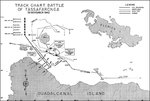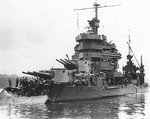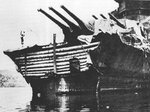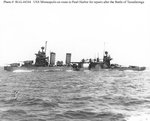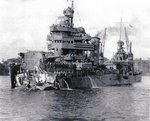syscom3
Pacific Historian
I'm of the opinion that this was the most humiliating naval battle lost by the USN. Pearl Harbor was a sneak attack. Savo Island was a wakeup call. But the horrific conduct by the USN that night was appalling. Already there had been four savage night fights in these waters, and the US still underestimated the capabilities of the IJN. Either way, hats off to all that fought that night. As bad as the admirals of both sides were, no one ever doubted the bravery of the sailors!
Background
On August 7, 1942, Allied forces (primarily U.S.) landed on Guadalcanal, Tulagi, and Florida Islands in the Solomon Islands. The landings on the islands were meant to deny their use by the Japanese as bases for threatening the supply routes between the U.S. and Australia, and to secure the islands as starting points for a campaign with the eventual goal of isolating the major Japanese base at Rabaul while also supporting the Allied New Guinea campaign. The landings initiated the six-month-long Guadalcanal campaign.
Following the Naval Battle of Guadalcanal, the Japanese command doubted their ability to retake the island and began to look at New Georgia, to the north of Guadalcanal, as a base from which they could thwart the American advance in the Solomons. The battleship and cruiser bombardments of Guadalcanal ceased, but the Tokyo Express continued its frequent supply and evacuation runs at night to the island. The Japanese Army General Staff was committed to continuing the Guadalcanal campaign and demanded more men, supplies and another 370,000 tons of shipping. While the War Ministry was reassessing the situation, the Japanese Navy devised a makeshift plan to deliver supplies to Guadalcanal. Large drums partially filled with medical supplies and food, with enough air space to provide buoyancy, were to be strung together with rope and hung from a destroyer's gunwales. When the ship arrived at Guadalcanal it would make a sharp turn, the drums would be cut loose and a swimmer from shore could pick up the buoyed end of a rope and return it to the beach, where the soldiers could haul in the supplies. The first test of this method resulted in this battle.
On the night of November 29, 1942, Rear Admiral Raizo Tanaka led a force of eight Japanese destroyers, with six carrying between 200 to 240 drums of supplies apiece, to Tassafaronga on Guadalcanal. Tanaka's flagship Naganami and Takanami acted as escorts. The other six destroyers were Kuroshio, Oyashio, Kagero, Suzukaze, Kawakaze, and Makinami.
Task Force 67, a recently formed cruiser/destroyer force that comprised the heavy cruisers USS Minneapolis, USS New Orleans, USS Pensacola, and USS Northampton, the light cruiser USS Honolulu, and four destroyers USS Fletcher, USS Drayton, USS Maury, and USS Perkins under the command of Rear Admiral Carleton H. Wright, steamed north from Espiritu Santo to interdict the Tokyo Express run. Destroyers USS Lamson and USS Lardner returning from an escort assignment to Guadalcanal were ordered to join up with Task Force 67, but lacking the time to brief the commanding officers of the joining destroyers they were assigned a position behind the cruisers.
Battle
On the night of November 29, Tanaka's force passed Tassafaronga point, and six supply destroyers prepared to loose their supply drums. One of the Japanese destroyers sighted destroyers of Wright's eleven-ship formation. Wright's flagship, Minneapolis, made radar contact with the Japanese ships. Ten minutes later the Fletcher's radar also picked up the Japanese 7,000 yards away. Just after 23:00, three U.S. destroyers launched twenty torpedoes while the American cruisers opened fire. Japanese destroyer Takanami was hit by numerous shells, her crew continuing to work their guns until the ship exploded and quickly sank. However, the American torpedoes missed the rest of the Japanese ships. The U.S. warship's gun flashes provided a clear target for the Japanese squadron, which quickly replied with twenty torpedoes of their own and turned to escape in the darkness.
The American ships failed to maneuver to avoid the Japanese "Long Lance" torpedoes, and the Minneapolis was hit by two 24-inch torpedoes which severed her bow, the New Orleans by one torpedo which also severed her bow, and the Pensacola by one torpedo below the mainmast on the port side that caused heavy damage and a fire. While USS Northampton was avoiding the three damaged cruisers, the Oyashio hit her with two torpedoes which caused her to sink later.
Aftermath
The damaged U.S. heavy cruisers managed to reach Tulagi harbor where emergency repairs were carried out. The three all managed to eventually make it to the U.S. for repairs, but all three were out of the war for more than nine months.
This battle underscored continued Japanese superiority in night actions and led to further discussion in the Pacific Fleet about changes in tactical doctrine. Of particular note was the lack of familiarity by Adm. Wright in using search radar (particularly against a land background in constricted waters) to offset the Japanese advantage in night optics, and the need for units to acquire experience in working together before being committed to night combat. Both of these lessons were partially rectified in naval surface engagements in the central Solomons in the following summer and autumn.
"It is a painful truth that the Battle of Tassafaronga was a sharp defeat inflicted on an alert and superior cruiser force by a partially surprised and inferior destroyer force."
Samuel Eliot Morison
Over the next few days, Tanaka made a second and third attempt to resupply Guadalcanal. However, American air and torpedo-boat attacks were so successful that only about 300 supply drums reached the Japanese troops. As a result of being cut off from food and medical supplies, starvation and malaria took a serious toll on Lieutenant-General Haruki Hyakutake's 17th Army.

